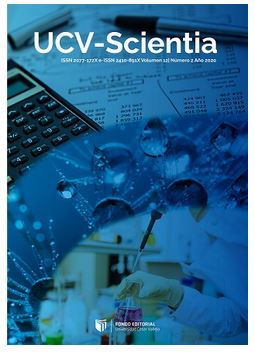The Super Latino Spa “The Ability to Sell Feelings”
DOI:
https://doi.org/10.18050/RevUcv-Scientia.v13n2a4Keywords:
selling ability; selling feelings; new business model; business case; entrepreneurship.Abstract
This Work aims to show a real case, of a model that has been created with the extraordinary smell of an entrepreneur who managed to understand how to sell more, profiting in a very special way the products she has in her business pool. This is the case of “Super Latino Spa”, a retail store of Caribbean food products (Includes: Products of Venezuela, Colombia, Dominican Republic, Mexico, Honduras and in general all of countries of Central America). This work it’s been modeling from the practice to the theoretical frame. It ́ ́ very important say at this time what we found in this practical paper development the interviews, meetings, and video recordings represents a basic model, but it is running in the real life, we can say 100% real working every day.
References
Abu EL Samen, A. and Akroush, M.N. (2018), “How customer orientation enhances salespeople’s performance? A case study from an international market”, Benchmarking: An International Journal. 55(27), 2460-2477, (2018).
Ambrosini, V., & Bowman, C. (2009). What are dynamic capabilities and are they a useful construct in strategic management? International Journal of Management Reviews. doi:10.1111/j.1468-2370.2008.00251.x. 11(1), 29-49,
Barney, J. (1991). Firm resources and sustained competitive advantage. Journal of Management, doi:10.1177/014920639101700108, 17(1), 99-120,.
Barney, J. B. (1986). Strategic factor markets: Expectations, luck, and business strategy. Management Science, doi:10.1287/mnsc.32.10.1231. 32(10), 1231-1241,. Corbetta, P. (2003). Metodología y técnicas de investigación social. Madrid: McGraw-Hill. https://n9.cl/tnrbk
McKenzie, D. (2017). Identifying and spurring high-growth entrepreneurship: Experimental evidence from a business plan competition. The American Economic Review. doi:10.1257/aer.20151404, 107(8), 2278-2307.
Drucker, P., Noel, J.L. (1986). Innovation & entrepreneurship: Practices and principes. https://www.jstor.org/stable/3380320. Journal of continuing higher education, 34 (1), 22-23.
Forés, B & Camisón, C. (2011). The complementary effect of internal capacity and absorptive capacity on performance: the mediating role of innovation capacity. http://dx.doi.org/10.1504/IJTM.2011.041680. International Journal of Technology Management. 55 (1), 56-8.
García-Morales, V. J., Ruiz-Moreno, A., & Llorens-Montes, F. J., (2007). Effects of technology absorptive capacity and technology proactivity on organizational learning, innovation and performance: An empirical examination. Technology Analysis & Strategic Management, doi:10.1080/09537320701403540, 19(4), 527-558.
Glaser, B. G., & Strauss, A. L. (1999). The discovery of grounded theory, Chicago. Aldine, doi:10.4324/9780203793206.
González Arancibia, M., & Naranjo Arango, R. (2012). Habilidades gerenciales del líder en las medianas empresas de la región Caribe colombiana. Revista Científica Teorías, Enfoques y Aplicaciones en las Ciencias Sociales. https://dialnet.unirioja.es/revista/16424/V/5. (10), 25-36,
Knight, F., Risk. (1921). Uncertainty & profit. Boston: Houghton Miffin. https://fraser.stlouisfed.org/files/docs/publications/books/risk/riskuncertaintyprofit.pdf
Kotler, P., Keller, K. (2012). Dirección de Marketing, 14ª edición, 20. Pearson Educación, México.
Nascimiento, L.S & Steincruch, F.K. (2019). “The interviewa were transcribed”, but how? Reflections on management reserch, RAUSP Management Journal. http://dx.doi.org/10.1108/RAUSP-05-2019-0092, 54 (4), 413-429.
Peteraf, M. A. (1993). The cornerstones of competitive advantage: A resource-based view. Strategic Management Journal, doi:10.1002/smj.4250140303, 14(3), 179-191,
Martelo, S., Barroso, C. & Cepeda, G. (2011). Creando capacidades que aumenten el valor para el cliente. Investigaciones Europeas de Dirección y Economía de la Empresa, 17 (2), 69-87, ISSN: 1135-2523.
Michael Rupert Peneder, Firm entry and turnover: The nexus with profitability and growth. Small Business Economics, doi:10.1007/s11187-007-9048-z, 30(4), 327-344, (2008).
Osterwalder, A. (2010). Business model canvas. Zurich: John Wiley & Sons. https://n9.cl/4o68r
Porter, M. (1980). Competitive strategy. New York: Free Press. https://n9.cl/nn1b8
Amit, R. & Schoemaker, P. (1993), Strategic assets and organizational rent. Strategic Management Journal. doi:10.1002/smj.4250140105, 14(1), 33-46,
Grant, R. (1991). The resource-based theory of competitive advantage: Implications for strategy formulation. California Management Review. doi:10.2307/41166664, 33(3), 114-135,
Rosas, O. (2011). La estructura disposicional de los sentimientos. Ideas y Valores. https://n9.cl/ql15s, 60(145), 5-31.
Sánchez, J. C. (2014). Habilidades cognitivas y éxito empresarial. Universitas Psychologica. doi: 10.11144/Javeriana.UPSY13-1.cses, 13(1), 321.
Schaefer, R. T. (2012). Sociology. United Kingdom: McGraw-Hill.
Solomon, M. R. (2010). El comportamiento del consumidor: Comprando, posicionando & vendiendo. Porto Alegre: Bookman,.
Strauss, A., Corbin, J. (2002). Bases de la Investigación científica. Técnicas y procedimientos para desarrollar teoría fundamentada. Ed. Univ. De Antioquia.
Suddaby, R. (2016). From the editors: What grounded theory is not. Academy of Management Journal. doi:10.5465/AMJ.2006.22083020, 49(4), 633-642.
Timmons, J. A., & Spinelli, S. (2016). New venture creation: entrepreneurship for the 21st century (Tenth edition ed.). New York: McGraw-Hill,
Valencia, M. (2015). Capacidades dinámicas, innovación de producto y aprendizaje organizacional en pymes del sector cárnico. Ingeniería Industrial. https://n9.cl/rt40z, 36(3), 297-305,
Yin, R. K. (1989). Case study reserch, design & methods, applied social reserch methods series (Vol. 5 ed.). London: Sage Publication. ISBN: 978-1506336169
Downloads
Published
How to Cite
Issue
Section
License

This work is licensed under a Creative Commons Attribution-NonCommercial 4.0 International License.
- Share — copy and redistribute the material in any medium or format
- Adapt — remix, transform, and build upon the material.
- The licensor cannot revoke these freedoms as long as you follow the license terms.
Under the following terms:
-
Attribution — You must give appropriate credit, provide a link to the license, and indicate if changes were made. You may do so in any reasonable manner, but not in any way that suggests the licensor endorses you or your use.
- No additional restrictions — You may not apply legal terms or technological measures that legally restrict others from doing anything the license permits.













